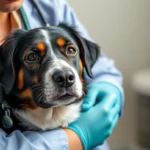
Dogs are curious creatures, often exploring their environment with their mouths. This behavior can lead to some unsettling situations, such as when a dog eats a wasp. Understanding why dogs might engage in this behavior, the risks involved, and the necessary actions to take afterward can help pet owners navigate this situation effectively.
Understanding Dog Behavior
Common Reasons Dogs Eat Insects
Dogs are naturally inquisitive and playful. Their instinctual nature often drives them to investigate everything within their reach, including insects. Here are a few reasons dogs might eat wasps:
-
Curiosity and Playfulness: Dogs tend to chase and capture moving objects, and insects provide an enticing target. The fluttering motion of a wasp can catch a dog’s attention, leading to an exploratory bite.
-
Instinctual Hunting Behavior: Many dogs have an inherent hunting instinct. This can manifest as a desire to chase and catch smaller creatures, including insects. This behavior is more pronounced in certain breeds, especially those bred for hunting or herding.
-
Nutritional Deficiencies: In some cases, dogs might eat insects if they are lacking certain nutrients in their diet. While insects are not a primary food source for dogs, they can provide a small amount of protein and other nutrients.
The Role of Pheromones and Scents
Dogs have an extraordinary sense of smell, which plays a significant role in their interactions with the environment.
-
How Dogs Are Attracted to Insects: The scents emitted by insects, including wasps, can be incredibly enticing to dogs. This olfactory stimulation can lead to a dog’s eagerness to engage with these creatures.
-
The Impact of Smell on a Dog’s Behavior: The powerful sense of smell allows dogs to detect pheromones and other chemical signals that may indicate the presence of insects, further encouraging them to investigate.
Risks of Dogs Eating Wasps
While the act of a dog eating a wasp might seem harmless, there are several risks involved that pet owners should be aware of.
Potential Reactions to Wasp Stings
Dogs may not only eat wasps but might also get stung in the process. Here are some potential reactions:
-
Allergic Reactions: Some dogs can experience severe allergic reactions to wasp venom. Symptoms may include swelling, difficulty breathing, vomiting, or even anaphylaxis, which is a life-threatening emergency.
-
Localized Reactions: Even if a dog is not allergic, a wasp sting can cause localized reactions. These may include swelling, pain, and irritation at the sting site. It can be uncomfortable for the dog and may require treatment.
Toxicity Concerns
-
Are Wasps Toxic to Dogs?: Generally, wasps are not toxic to dogs in the same way that some plants or chemicals might be. However, their venom can lead to serious health issues, especially in allergic dogs.
-
Differentiating Between Wasps and Bees: It’s essential to distinguish between wasps and bees, as their venom and potential effects on dogs can differ. Bees leave their stinger behind, which can cause more localized issues, while wasps can sting multiple times.
Secondary Risks
Aside from the immediate risks of stings and reactions, there are secondary risks to consider:
-
Possible Gastrointestinal Issues: Eating a wasp can lead to gastrointestinal upset in dogs. This may manifest as vomiting or diarrhea as the body reacts to the foreign object.
-
Risk of Choking or Obstruction: Depending on the size and number of wasps ingested, there is a risk of choking or a blockage in the digestive tract. This can be a serious condition requiring veterinary intervention.
Immediate Actions to Take
If you find yourself in the situation where my dog ate a wasp, here are the steps you should take:
Assessing Your Dog’s Condition
After ingestion, it’s crucial to monitor your dog closely for any signs of adverse reactions. Look for:
-
Signs to Watch For: These could include excessive drooling, pawing at the mouth, swelling around the face or muzzle, difficulty breathing, or unusual behavior.
-
Importance of Monitoring Behavior and Symptoms: Keeping an eye on your dog’s behavior can help you determine the severity of the situation. If your dog appears distressed or unwell, it’s essential to act quickly.
First Aid Steps
In case your dog gets stung, here are some first aid steps to consider:
-
How to Treat a Sting: If your dog gets stung, you can apply a cold compress to the affected area to reduce swelling and pain. Over-the-counter antihistamines like Benadryl can help, but consult your vet for the correct dosage.
-
When to Induce Vomiting: If your dog has just eaten a wasp and you are concerned, contact your veterinarian before attempting to induce vomiting. They can provide specific instructions based on your dog’s health and the situation.
When to Seek Veterinary Care
Certain signs indicate that immediate veterinary care is necessary:
-
Signs That Require Immediate Attention: If your dog is showing any signs of an allergic reaction, such as swelling of the face, difficulty breathing, or severe vomiting, you should seek emergency veterinary care.
-
What to Expect During a Vet Visit: The vet will assess your dog’s condition, possibly administering antihistamines or steroids if an allergic reaction is suspected. They may also check for signs of gastrointestinal distress or obstruction.
Long-Term Considerations
Addressing the immediate concerns of wasp ingestion is vital, but long-term considerations are equally important.
Managing Allergies
If your dog has an allergic reaction to wasps, it’s essential to manage this condition carefully:
-
Understanding and Identifying Allergic Reactions: Keep a close watch on your dog’s behavior after a sting, and familiarize yourself with the symptoms of allergic reactions.
-
Potential for Future Stings and Allergic Responses: If your dog has had an allergic reaction, they may be more susceptible to future stings. Discuss long-term management strategies with your veterinarian.
Preventive Measures
Preventive steps can help reduce the likelihood of your dog eating wasps in the first place:
-
Training Your Dog to Avoid Insects: Implementing training techniques can teach your dog to ignore insects. Positive reinforcement for ignoring wasps can be effective.
-
Environment Management: Keeping your yard clean and free from standing water can help reduce the number of insects. Ensure that your dog’s play areas are well-maintained and monitored.
Regular Veterinary Check-Ups
Routine veterinary visits are crucial for maintaining your dog’s health:
-
Importance of Routine Health Checks: Regular check-ups can help catch any potential health issues early, including those related to insect consumption.
-
Discussing Any Concerns Regarding Insect Consumption: Open communication with your vet about your dog’s behavior and any concerns you have regarding insects can lead to tailored advice for your pet.
Frequently Asked Questions (FAQs)
Can wasp venom harm dogs?
Yes, wasp venom can cause harm to dogs, especially if they are allergic. It can lead to severe allergic reactions or localized swelling and pain.
What if my dog is allergic to wasps?
If your dog is allergic, it’s crucial to manage their exposure to wasps and have an emergency plan in place, including a supply of antihistamines as recommended by your vet.
Are there specific breeds more prone to insect-related issues?
While any dog can potentially have an allergic reaction, certain breeds may be more prone due to genetic factors. Discuss breed-specific concerns with your veterinarian.
How can I train my dog to leave insects alone?
Training can involve teaching commands such as “leave it” and rewarding your dog for ignoring insects. Consistent practice and positive reinforcement are key.
Conclusion
Understanding what to do if my dog ate a wasp is crucial for every pet owner. By being aware of the potential risks associated with wasps, monitoring your dog closely after such incidents, and taking preventive measures, you can ensure your furry friend stays safe. Always consult your veterinarian when in doubt, as their expertise is invaluable in managing your pet’s health and well-being.
Stay vigilant and ensure a positive environment for your dog, and don’t hesitate to seek professional advice when necessary. Keeping communication open with your vet will help you navigate any concerns regarding your dog’s interactions with insects.









